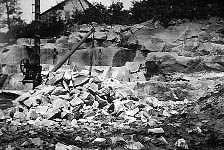
 Dimension stone is stone sold in blocks or slabs, and is used in building. It
must be workable, uniform in texture and grain size, and attractive in
appearance. The early West Virginia settlers had plenty of lumber, and did not
feel the need for stone. However, after the Civil War the centers of
population grew rapidly and the use of native stone also grew. The sandstone
was used for buildings, bridges, paving and curbing, and stone walls. By the
early 1900s there were as many as 60 dimension stone quarries in West
Virginia, primarily in the western part of the State. Although the use of
building stone decreased with the development of new building materials, in
recent years it has once again gained popularity.
Abrasive Stone
Abrasive sandstone was used in making grindstones and pulpstones. The
grindstone was then used for sharpening tools and instruments, and the
pulpstone for crushing wood into fiber at pulp mills. The Marietta sandstone,
outcropping along the Ohio River, is especially good as abrasive stone and has
been the second most important grindstone horizon in the U.S. Around 1900
there were quite a few grindstone quarries, primarily in the Parkersburg
area. But demand decreased, and by 1957 only one grindstone quarry
(Constitution Stone Company, Jackson County) and one pulpstone quarry
(Smallwood and Low Sandstone Company, Monongalia County) were still in
operation. Today there are no active abrasive stone quarries in the State,
as native stone has been replaced by new materials.
(adapted from an article by Jane R. Eggleston, updated September 1996)
Dimension stone is stone sold in blocks or slabs, and is used in building. It
must be workable, uniform in texture and grain size, and attractive in
appearance. The early West Virginia settlers had plenty of lumber, and did not
feel the need for stone. However, after the Civil War the centers of
population grew rapidly and the use of native stone also grew. The sandstone
was used for buildings, bridges, paving and curbing, and stone walls. By the
early 1900s there were as many as 60 dimension stone quarries in West
Virginia, primarily in the western part of the State. Although the use of
building stone decreased with the development of new building materials, in
recent years it has once again gained popularity.
Abrasive Stone
Abrasive sandstone was used in making grindstones and pulpstones. The
grindstone was then used for sharpening tools and instruments, and the
pulpstone for crushing wood into fiber at pulp mills. The Marietta sandstone,
outcropping along the Ohio River, is especially good as abrasive stone and has
been the second most important grindstone horizon in the U.S. Around 1900
there were quite a few grindstone quarries, primarily in the Parkersburg
area. But demand decreased, and by 1957 only one grindstone quarry
(Constitution Stone Company, Jackson County) and one pulpstone quarry
(Smallwood and Low Sandstone Company, Monongalia County) were still in
operation. Today there are no active abrasive stone quarries in the State,
as native stone has been replaced by new materials.
(adapted from an article by Jane R. Eggleston, updated September 1996)
Please send questions, comments, and/or suggestions to webmaster.
Page created and maintained by:
West Virginia Geological and Economic Survey
Address: Mont Chateau Research Center
1 Mont Chateau Road
Morgantown, WV 26508-8079
Telephone: 304-594-2331
FAX: 304-594-2575
Hours: 8:00 a.m. - 5:00 p.m. EST, Monday - Friday
Permission to reproduce this material is granted if acknowledgment is given to the West Virginia Geological and Economic Survey.